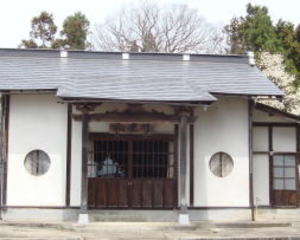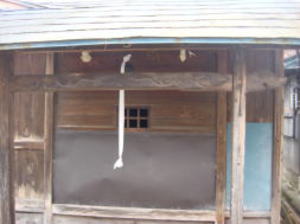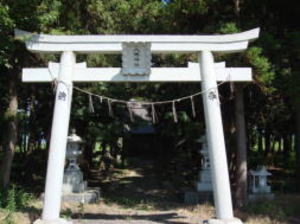0.1km further east than the current location. Unknown the when, it is said that evacuated and moved to the current location.
The settlement is located on the terrace formed by the mountain-building
activity of the Aizu basin western edge falt zone and
eroded by the Tazawa-gawa river.The place that is considered to be the old place of the temple is, it the rice field and it has
become a considerable lowland, and the reason for the relocation can be
easily judged even if the current Tazawa-gawa river
basin is seen. In addition the opening village is, it is said around Tenshō 2 year (1574 year). And in Kanbun years (1661 year ~
1672 year), it is said that the Principal Buddha changed from Amida-Nyorai to Shaka-Nyorai, but the reason is not understood.
By the way, from
the "Shōbuzawa-tōge pass" in the Unai district, the Mimyō ― Tōdera ― Sugi ―
Funakubo ― Daimura ―
through Kachigata, Takada (Takada
district, Aizu-Misato town) ― Hongō (Hongō district, Aizu-Misato town) ― the road of the
mountain to Kurokawa (Aizu-Wakamatsu city), it was the ancient "Echigo-Kaidō
road" that came and went between Aizu and
the Sea of Japan before the Echigo-Kaidō road crossed the Aizu Basin.
It was also part of the ancient "Yamanobe-no-michi
(Mountain Side Road)" from Echigo(Niigata prefecture) and Aizu(Fukushima prefecture) to the present Kantō region. It is said
that the escape route of the "Tōdera Hattan" of the legendary
thief of Aizu-Bange is this road, and it is also called "Hattan-dō
road". Even on a road
that seems to have nothing, there are some pretty interesting episodes isn’t it!
A phantom thie of
Tōdera Hattan the Aizu-Bange storyteller version.
Once upon a time, it hear that there was a thief with the nickname called Tōdera-Hattan
in the Tōdera.The thief is very fast,
because the officer of the magistrate’s office cannot possible to caught by all means, they had an unpleasant experience.
When he steal some goods, he go beyond Sannō-tōge pass at night to Imaichi
(Imaichi city, Tochigi prefecture) and Kanuma
(Kanuma city, Tochigi prefecture), it is said that he sold it in the morning-market
and changed it to money, and he came back in
the morning and slept in the daytime. It seems not to have been able to catch it as an official at that time because there was no
evidence because it went to the Imaichi and Kanuma and the stolen goods were sold.It is said that Tōdera-Hattan was
originally his work was the express messenger because the foot was fast.At one day, he ran into a gang of thieves in the
mountains while he was working in an express messenger.Still, he was so
strong that he quickly defeated the thieves group.
Then, to the thieves group, "We want you to become our boss",
that it was a wake to become a thief that it was asked.The origin
of the nickname of "Tōdera-Hattan" is, connecting the cloth
of Hattan, and start running to wind one side around the waist, it
was so fast that the other end didn't hit the ground.Still, it is said that it turned oneself in the magistrate’s office and
it went
out because it has become not able to run fast because it gets old and it has become And, it seems to have become a punishment
of the death by burn in Wakamatsu without an extenuation of the amount of consideration.
It's important to
make an effort to make the best use of what you're good at for the world and
for others!
Because the length
of one cloth Ittan of one Kimono is about 9m, Hattan will be 72m.
How far is the speed
of the foot of "Tōdea-Hattan" is’nt it???
(Welcome map, Aizu Bange town South area map)
Also as the god of Sake brewing, it is a letter written by Sumi ink that says that it was originally enshrined in Enichi-ji temple,
Matsuo-Kamenori-Daizenshin is enshrined. The origin is not clear.
The "Matsuo-Kamenori-Daizenshin" is, the "Matsuo" means to "Matsuo Taisha shrine(Kyoto)".
Kamenori means, represents of
the statue shape to riding on the back of a turtle. Daizenshin is generally,
it represents the guardian deity of Buddhism, god of
the Gohō-Zenshin(protection law). It is called the guardian deity. There
is Matsuo-god on the 13th day of the 30-gods in the Gohō
-Zenshin. The 30-gods are the 30-pillar gods who say that they protect
the nation and the peoples on a daily basis in the faith
syncretization of Shinto with Buddhism. Matsuo-Kamenori-Daizenshin is, it will be that Matsuo god who got on the turtle.
Matsuo-Taisha shrine in Nishikyo-ku, Kyoto city is a shrine that Mr. Hata,
a Toraijin (people from overseas), made a guardian
god. With the following relocation of national to the city of Heiankyo,
it is revered as the god of guardian of the imperial palace.
In addition, turtles have a deep relationship with water, and since the Middle period, Matsuo-god have been believed to be the
god of Sake brewing, because Mr. Hata also introduced the Sake brewing
technology to Japan. In the Gohō-zenshin, there are
gods such as Bonten, Taishakuten, Four heavenly kings, Idaten, Ashura,
Benzaiten, and Daikokuten etc..
(Welcome map, Aizu Bange town North-West area
map)
Takadera Buddhism was abolished after it was destroyed by a fire in the
battle with the allied forces of Enichi-ji temple and
Echigo's (Niigata prefecture) Jō-Shirō-Nagamochi. Why did it become a battle though Tokuitsu of Enichi-ji temple was rebuilt?
At that time, there was a debate about the doctrine between Takadera temple
and Enichi-ji temple. Moreover, Mr. Jō of Echigo
Mr. Hei(Taira) was plotting to put Aizu under the power of Mr. Hei, and attacked the Takadera temple by plotting with Einichi-ji
temple. In the temple of was at this time, even though the monk, there
was a group of monk soldiers with weapons. It is peoples
like Benkei of the subordinates of Minamoto-no-Yoshitsune. Because the doctrine controversy between temples sometimes
developed into violent incidents, monks were armed as a defense organization
of the temple. After that, even though it was
rebuilt, it was devastated by many fires, "there is a Miroku-dō in
here, the wrecked was Tenbun 20 year (1551 year) Shamon
(buddhist priest) called Yūsen is repaired and built a thatched hut, and the Miroku-Buddha was the Principal Buddha and
enshrined in the Guest-hall." it is described in the Shinpen-Aizu-Fudoki.
This Tenbun 20 year is to founded year. In addition, it
encountered several fires, and dilapidated temple in Shōwa period.
Crossing the old Route 49 in front of the Eryū-ji temple gate (the old
Echigo-Kaidō road), "Hatago-ya(Ryokan, inn), Nabeya honke
(original house)" and "Tōdera streets scape preservation association" sign board was hung, it entered the alley beside the private
house, and the area including the cemetery which is a meeting place in
the Todera district now which crosses the Tera-bashi
bridge is the ruins of Seigan-ji temple. Now, the Jizō stands at quietly,
and the ruins of Seigan-ji temple are no more than a
shadow of the old days.
As a native of the town, it cannot forbid loneliness because of the idea
that this is the land of the end of the Takadera temple
Buddhism.
(Welcome map, Aizu Bange
town North-West area map)
official permission Buddha statue was made".
During the construction time of the Three-way road in Meiji 15 year (1882
year), the precincts were divided north and south
because the route penetrated the center of the village. It is said that
the village was managed mainly in this temple before the
Meiji period, and the sacrifice of the main hall and the graveyard at
this time large. Until about Shōwa 40 year (1965 year) when
I was a high school student, there was Kannon-dō in the precincts and Koyasu-Kannon was enshrined, but in recent years it has
become so decaying that it has been demolished for the widening construction
of National route 49, and the Kannon statue
enshrined in the main hall.
In Aizu-Koruiki, Kawanuma county Murata village fortress, East-West 28-Ken
(51m) North-South 31-Ken (56m), Angen 2 year
(1176 year), Kurosawajiri Uhyōe-no-jō Masafusa, this person is a child of the fourth son Masatō of Abe-no-Yoritoki, and is the
second son of Kogorō Masakatsu. He left Aizu and served in the Enichi-ji
temple of Ō-dera(Ō-dera town, Yama county) but, and
he lived here in possession of the territory Murata. It is said that the
28th generation of Murata Bunjiuemon Fusanaga is Tenshō
17 year (1589 year), Enichi-ji temple was defeated along with the Ashina
family in the Aizu invasion of Date Masamune, and
lost his job. The location of the mansion is not sure at this time. It is presumed that
the area around Chōei-ji temple is the ruin
of the mansion, but the ruins cannot be confirmed. It might have been destroyed by the Three-way road construction of the
Meiji
period, and the road widening construction which repeatedly afterwards.
The samurai of the relation of the Abe-no-Yoritoki and Sadatō of the mastermind of the Ōshū side of the Former 9 years war
(1051 year ~ 1062 year) were in Aizu by 100 years and 500 years later weren’t you ?.
(Welcome map, Aizu Bange town East
area map)
the Ihon-Tōdera-Ngachō, the disciple Taien of Tennei-ji temple (Aizu-Wakamatsu
city) Nanei, will build the Gyūtakuzan Daitoku-ji
temple in Ushizawa village in Kawanuma county.In the Shinpen-Aizu-Fudoki, it is said that the monk of the Shingon-sect
Sosatsu
who were founded Daitoku-Bō in the Tenbun 17 year (1548 year, when it
had been rivalry of local warlords in the late Muromachi
period), and this year is assumed to be the year of the founding. In addition, in the Teanshō 9 year (1581 year, the year before
Oda Nobunaga death the Honnō-ji temple incident), the monk Kōgan invited
Jinan of Tennei-ji temple to founder of the temple,
and at that time he converted from the Shingon-sect to the Sōtō-sect.
It is a temple that is burnt down in the Kaei 1st year (1848
year, the time of Odaiba(gun turret) construction for the defense of Edo bay), and is rebuilt afterwards, but dignified the style
stately of the old days. There is also it a the building structure the
hidden room in the main hall. It is thought that the hidden
room was used for security measures and secret meetings. In the main hall,
various Buddhas such as the Gochi-Nyorai(Five
Wisdom Buddhas) statue which escaped from the fire and the Batō(horse- head) Kannon statue are enshrined. Moreover, it is
presumed that there might have been a Enma-dō(Hell King’s hall) before
because there is a statue of Datsueba (old woman who
rip off one’s clothes in hell). These statues, including the principal image, are said to have been inherited from the Tenshō period
(1573 year ~ 1591 year). Other Dainichi-Nyorai seated statue, Fudō-Myō-Ō
standing statue, and thirty-three body Kannon statues
are enshrined, and at the beginning of its founding, various halls such
as Nyorai-dō and Kannon-dō are lined up in the precincts,
It presume that it was a magnificent temple that represented the Shingon
world.
The temple gate built from all-cypress, was rebuilt in Sh wa 58 year (1983 year), and was designed to be the same as the temple
wa 58 year (1983 year), and was designed to be the same as the temple
gate of Jyōrin-ji temple of the Aizu-Bange 5 temples. The Bell-tower was
rebuilt in Heisei 7 year (1995 year).
It is said that the name of the Ushizawa village, in order for the Kūya-shōnin (964 year, founded the Huyukizawa Hachiyō-ji temple
of Aizu-Wakamatsu city) to spread Buddhism when went down to Aizu, from
the capital(Kyoto) and rode a cow to visit Eryū-ji
temple, came to Akazawa. It is said that it was changed to "Ushizawa" because this cow died suddenly and became a stone.
According to the Wakamiya-Local-History the village was previously referred
to as "Akasawa". The occurrence of Akasawa's name
is, it is said that the village name became Akazawa because the water of
the Tazawa-gawa river which is over the Mumyō-bashi
bridge in front of Daitoku-ji temple gate contains a lot of iron, and the river stone turns red. Even now, the bottom of the river looks
a little reddish. After the Meiji period, it was the administrative center
of the Wakamiya district as a location such as Wakamiya
village town hall, Ushikawa elementary school, and police representative
office.
When I asked an elderly person in the neighborhood, some of the villagers
in their before the 60s, it was said that the number of
people who can read the honorific mountain name as "Gyūtakuzan"
is decreasing, too.
(Welcome map, Aizu Bange town South area map)
branch temple of Tennei-ji temple (Aizu-Wakamatsu city) in the Meireki 2 year (1656 year, the lord of Aizu at this time was Mr.
Hoshina Masayuki) afterwards. Perhaps the Keichō 16 year (1611 year) rebuilt what was damaged by the
Aizu large earthquake.
The main hall was evacuated during the Pacific War, and it caught fire
and burned it down by the carelessness of the evacuated
person. It combine
as a meeting place in the village, and the main hall form is arranged in one
part and it rebuilds it. Recent years
the decay of the main hall has become violent, it was rebuilt in Heisei 22 year (2010 year). In place of the burnt-out Principal
Buddha Kannon-Bosatsu, the statue of Syaka-Nyorai, who was new tone as
the principal image in Heisei 15 year (2003 year), is
enshrined.
The precincts were located in the sedimentary hills of the Tsurunuma-gawa
river, and from here, the area that became a rice field
in the east direction was the river-boat wharf of "Saimya-ji across
river".
(Welcome map, Aizu Bange
town Center area map)
origin of the village name is that there was a Mumyō-mon gate in the village
when Renku was built in Emperor Saimei 4 year
(658 year), and it was changed to the Mimyō-mon gate at that time when the temple was at the height of its prosperity.
It is said that there was a gate near the Ōyamazumi shrine of the village's guardian,
and there was also a monk’s house, but the
cornerstone and remains of the gate have not been discovered yet.
Hōki 6 year (775 year) the Takadera was destroyed by a fire in the battle
with Tennei-ji temple (Higashiyama, Aizu-Wakamatsu
city). In Enryaku 23 year (804 year) when the monk Rijin was revived and
at the time of the prosperity, Seishō-ji temple was
opened as the branch temple of the Takadera. In Yōrō 1st year (1181 year),
the Takadera was destroyed again by a fire in the
battle with the allied forces of the Jingamine castle Jō Shirō Nagamochi
and Enichi-ji temple. At this time, the temple also
encountered a disaster, but the monk Kōkaku was revived in Tenshō 1 year
(1573 year). In addition, in the Shinpen-Aizu-Fudoki,
it is said that all of the temple and the principal image were destroyed
in the fire in the Bunroku 4 year (1595 year).
In Shōhō 1 year (1644 year), the monk Sakuun became a priest and then became the branch temple of Erin-ji temple (Aizu-
Wakamatsu city), and at that time converted from Shingon-sect to Sōtō-sect.
Since the decay of the main hall has become violent,
it was renovated in Shōwa 62 year (1987 year, the year of the split privatization
of Japan National Railways). There is a Taishi-dō
hall in the west of the village away from the temple, and it is presumed that the temple in the early period was built in the vicinity
though the statue of Prince Shōtoku is enshrined.
(Welcome map, Aizu Bange
town North-West area map)
that it worked to bundle the grass of the food of the cow horse such as
reeds. The temple's founding open temple is unknown.
Principal Buddha is seated statue of Jizō-Bosatsu. The temple was damaged by the Shirohigeno-Ō-mizu(big flood of the white
beard) in Tenbun 5 year(1536 year), and it is said that the Kannon-dō
temple where the priest's Ryōjun was in the temple and
the village south, was relocated to the present place in Genroku 15 year(1702
year), and revived with Kannon-dō temple.
The principal Buddha of Kannon-dō in front of the main hall (the building
in front of the photo), in wooden statue carved from
one tree, Sanmen-Happi(three-faces and eight-arms, face is three sides
of the front, left and right, eight arms) Batō (Horse-head)
Kannon standing statue (the constructed time is unknown). It is a sacred place of "Japanese heritage Aizu 33 Kannon's 11th
pilgrimage site".
It is said in Aizu-Kagami, Tsukahara fortress ruins, East-West 36-Ken(65.5m), North-South 40-Ken(73m) Ninagawa Syōgen
Toshikage, Jyōwa 2 year(1313 year) built and live, descendants make Tsukahara
a family name. And there at the period of
Tenbun, Satō Umanosuke Yoriharu lives, the descendants are Tsukahara as
the family name. In the Aizu-Koruiki, it is said that
there was Tsukahara-mansion of the Ashina clan’s senior vassal Hirata Hyōbu Shōyū (Hyōbu Shōyū is official name of military
officer in Ritsury system. Deputy minister of defense in now. Mr. Hirata is a military officer
of the Ashina clan.) in later years.
system. Deputy minister of defense in now. Mr. Hirata is a military officer
of the Ashina clan.) in later years.
The area around the grove facing the rice paddy in the northern part of
the settlements is the ruins of the mansion.
Although it is only a little, it can see the remnant of the earthwork and
the moat.
In the Tsukahara settlements, the following legends have been handed down. The giant-snake extermination of Sawara Jyūrō
Yoshitsura.
Sawara Jūrō Yoshitsura is the ancestor of Mr. Ashina of Aizu-Heishi, he was a powerful warlord of Bandō-Heishi, who was in
possession of Sagami country Sawara and Miura (Yokosuka city of Knagawa
prefecture, Miura peninsula) and was instrumental
in the establishment of the Kamakura Shogunate.
Bunji 5 year(1189 year), after the conquest of Ōshū-Mr. Fujiwara, given to Aizu from Minamoto-no-Yoritomo and entered Aizu.
Because he heard the wishes of the residents and lived in Aka-numa(red
swamp) in Kami-Tsukahara, got rid of the giant-snake
and saved the hardships of the villagers, it is reported that he was awarded
the award by Emperor of time (Emperor Gotoba).
There is no Aka-numa now. Since Emperor Gotoba was plotting to recapture the regime, there is no reason to be interested in
the trend of warlords of the Kamakura Shogunate moreover in Ōshū (Tōhoku),
it might have been added to the posterity to say
that it was awarded the favor prize. If the award is to be awarded, it
will be from Minamoto-no-Yoritomo of the Kamakura
Shogunate. To Sawara Jūrō Yoshitsura, the legend of the giant-snake extermination of Lake Numazawa (crater-lake) in
Kanayama town, Ōnuma county is also transmitted. In the "Kanayama
Festival", a skit of the giant-snake extermination of
Sawara Jūrō Yoshitsura is performed on the lake. There is no reason to
there is such a big snake that it is not possible to
extermination of it if it is not a warlord, is exterminated the Local-lord or Bandits group by Sawara Jūrō Yoshitsura, might be
telling it by making it a beautiful story. To control the anarchy of Aizu without an absolute ruler, it is thought that it was the one
that the battle to subdue the local-lord and the bandit group of in various
parts of Aizu was carried out. In recent years, it has
been theory that Sawara Jūrō Yoshitsura was busy with his duties as an administrative official of the Kamakura Shogunate,
and that he was not actually in Aizu. After Yoshitsura, because it was
settled in Aizu in the age of the children of 2nd generation
Moritsura, without being involved in internal strife of the Kamakura Shogunate,
we were able to govern Aizu for 400 years.
This is a very rare example in the history of Japan.
In the Miura
peninsula, Kanagawa prefecture, the place names of Sahara and Ashina are left.
Miura Peninsula is the production area of "Miura Daikon (radish)"
rare species, Kannon-zaki cape Lighthouse, Aburatsubo bay
Marine Park, Mikasa Memorial Park, as well as tourist attractions such
as marinas and beaches are scattered around.
It was also a play
spot for my youth, along with the Shonan coast and a place to recognize again
Mr. Ashina of Aizu.
(Welcome map, Aizu Bange town East
area map)
I think that the opening village of the Tsukahara settlements is at this times.It think that peoples began to gather from the
surrounding area by cooking at logistics bases, raising horses and supplies for food. Because the area around the shrine was a
military base at that time, the general population did not let in. This
is why the shrine and the resident's residence are separated,
though it is the guardian god of Tsukahara. In Aizu-Bange town, only this
Hachiman shrine is "Shō-Hachiman". At this time,
pitch a camp in the Shimo-Mandokoro district, prayed for victory prayer
and the healing of diseases, and from "Iwa-Shimizu
Hachiman Shrine" in Kyoto, transferring it to "Kokoro-Shimizu Hachiman Shrine" to Midoriyama in the Tōdera Matsubara
district. The expedition army which rebuilt the army here is a place with the history
which is said to lead to the victory of the post
of the Former 9 years war ahead of victory in the first match near the
Shirohata Hachiman Shrine of the Shimo-Mandokoro.
The expedition army that rebuilt the army here, the victory in the first match in the vicinity of the Shirohata Hachiman Shrine of
the Shimo-mandokoro, it is a place with a history which says that it leads to the victory of
the Former 9 years war.
It is said that the former precincts were covered with a lot of huge trees,
and it was possible to confirm the location of the shrine
easily from the top of Mt. Bandai.It wonder if the legendary monster of Mt. Bandai, the Long-hand, and the
Long-leg were also
looking at this Hachiman-sama from the top of the mountain.
What the legend of monster of Mt. Bandai is "Long-hand and Long-leg
"is…, in Aizu-Bange Kataribe(storytellers) version…,
It was a long long time ago, it hear that there was a monster who called
the Long-hand and Long-leg in Mt. Bandai.
It hear that
the Long-hand was long enough to sit on Mt. Bandai and wash his face with the water of Lake Inawashiro.It hear that the Long-
foot was long and was large, so that it was possible to cross Mt. Bandai and Mt. Myōjin-dake.
The Long-foot is stands on the Mt.
Bandai, and raking the clouds and interrupts the sun light, the Long-hand is raked up the water of Lake Inawashiro and rained
it, there were bad.
Therefore, that the crops in the fields don’t grow up, only in the weather of cloudy or rain always in the village
under the mountain, and it was in trouble.
One day, a
traveling monk came to the village, and begged him to "Please do something". "That's good. Let's get rid of it.", said
the monk and climbed the Mt. Bandai with the jar, and he was told.
"Hey! Long-hand Long-leg, I heard you can be any shape, then can you be
in this jar?" that it was said.
Then, two peoples of the Long-hand and Long-leg said, "It is of
course, and such a thing is easy." it said that it entered the jar.
The monk quickly closed the lid of the jar, it that Goma-daki (to make
a fire-offering), to offer a prayer, and has confined the Long-
hand and Long-leg.
It is a story that
the monk of the travel was Mr. Kōbō-Daishi Kūkai of a young day.
By saying so, it hear that the Long-hand and Long-leg are enshrined in
the Bandai-Myōjin shrine at the top of Mt. Bandai now.
(Welcome map, Aizu Bange town East
area map)
in Shōwa 52 yaer(1977 year), "The Sankai,Banrei(three realms, all
souls), Genbun 4 year(1739 year, the period of Shōgun
Tokugawa Yoshimune)" was found in the building ridge tag written by
Sumi ink. Legend had it that the old settlements sits about
north of 0.5 km. In the excavation survey before the agricultural field
maintenance, the remains of the settlements have been
confirmed. Think the reason is for the relocation probably that moved to avoid flood damage. Along with the relocation of the
settlements, the temple might have moved to this place, too
What the Sankai, Banrei (three realms, all souls) is, the Sankai (three
realms) is Buddhist word such as Yokkai(the realm of
desire), Shikikai(the realm of form), and Mushikikai (the realm of non-form)
or said that it is the realm of Buddhahood, the realm
of the living, the realm of oneself, or to say the past, present, and future. It is said appetite, sexual desire, and sleep desire to say
the realm of desire world. The realm of form says that the sexual desire
is stronger than the appetite, and the realm of non-form
says the world of the mind without the sexual desire. Banrei (all soul’s)
is a world that does not stop by the vivid flow of all living
things, referring to all the worlds of the spirits of the lust, the realm
of form, and the realm of non-form.
I wonder if this interpretation was good. In any way, whatever it is,
it's all about it. In the precincts of the temple, the three worlds
are written "Sankai-Banrei(three-reams, all-soul’s)", and a stone monument and a wooden bill are built, and it is a Sangai-Banrei
remembrance service the spirits of all the world, and to offer them. It
is said to be a memorial service for the Sangai-Banrei and
the unrelated Buddha.
(Welcome map, Aizu Bange town Center
area map)
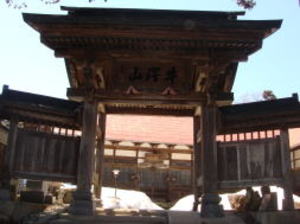
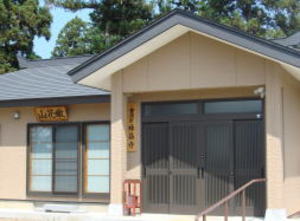
Shingon-sect Buzan-school
Tokueizan Jōtoku-ji temple
From the front of Bange Kōsei Hospital to the south, crossing the JR Tadami Line crossing
1.5km passed through the Ushizawa village and through the tunnel near
the Bange-tunnel
on the Ban-etsu Highway and it is located east of the Daimura village
entrance.
The founding is in the Aizu-Kuji-Zakkō, it is said that in Meiō 1 year (1492 year), the monk
Nōzan of Shimousa country (Southwestern Chiba prefecture, East end of
Saitama prefecture,
East bank of Sumida-gawa river of Tokyo) built Sen-yō-ji temple in Inagawa-shō
Daimura
village. Principal Buddha is
Shaka-Nyorai seated statue.
Since the founding of Meiō 1 year,
disasters such as earthquakes and floods have been, it is said that the
temple was in place
It is said that the temple at the time of its founding was in the mountains about 100 m further from the present location.
Principal Buddha is Shaka-Nyorai seated statue. The temple was destroyed
by fire in Shōwa 28 year (1953 year), and was rebuilt
in the Shōwa 41 year (1966 year) with a fire-resistant structure of reinforced
concrete.
Kachigata village is, Tengi 5 year (1057 year) the Tōdera Hachimangu shrine
shinto priest list, it is a village that has been opened
for old time because the village name of Kachigata is on it. The backmountain
of the temple is the graveyards. Furthermore in the
place where it is deeper, at the time of the Boshin-war, unable to evacuate to Tsuruga-jō castle and arrived here with the
cooperation of the residents. However, seeing the smoke burning the castle
town, and feel gloomy about the future in the
information that Mr. Nanma and Mr. Machino were killed in the war, and
the Aizu clan's first corps cheef Nanma San-emon
family, two families of the Shichū Suzaku 2nd corps cheef Machino Gen-nosuke family, from a 47-years-old mother to a 4-years-old
child, there was a terrible event called group suicide. Later, it was
that the two men were killed in the war it was false alarm.
In order to mourn this spirit, a martyrdom monument was built in the Heisei
5 year (1993 year) with the cooperation of the
volunteers of the descendants and Aizu-Bange. A memorial service is held
every September.
(Welcome map, Aizu Bange town South
area map)
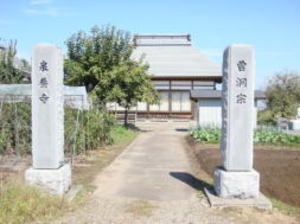
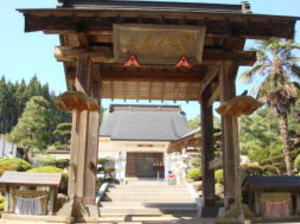
The Shimo-Mandokoro was in the "List of Konoe family territory"
of the Yōmei Bunko, and it was the Reizei family territory, and
it was a territory of the Royal princess Kenshi of the Reizei-no-miya.
It is said that the government office of Ninagawa-shō was
put in the Shōen(manor) of the Regent’s family territory. The settlements is originally though it was in the place about 0.3km
away to the north, it is said that it escaped from frequent flood damage
and it moved to the present placeut. It is said that the
area where Jūfuku-ji temple built is a place where there was a medieval
Mandokoro mansion, but the details are not known
because there has been no academic research. In a part of the precincts, it can see the evidence that is thought the
traces of
mounds. It seems that it was never rebuilt the
mansion.
(Welcome map, Aizu Bange town North-West area
map)
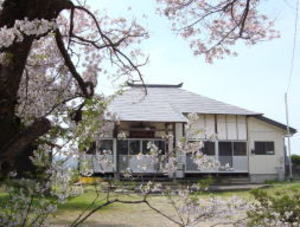

The Takadera where by the monk Seigan of the Chinese Liang country founded
in Emperor
Kinmei 1 year (540 year), it is burnt down by the fire in the battle with
the peoples of Tennei-
ji temple (Higashiyama, Aizu-Wakamatsu city), and it becomes an dilapidated temple. Daidō
3 year (808 year), where has the temple, which was revived with Eryū-ji
temple by Tokuitsu
of Enichi-ji temple and was named Seigan-ji temple of reration the Seigan? Tokuitsu moved
the Eryū-ji temple in the Takadera to the present location and reconstructed
the Takadera 36
-Bō centering on Eryū-ji temple. Originally, there was a Takadera 36-Bō
Jikō-Bō in the Tōdera,
and Tokuitsu named Jikō-Bō "Seigan-ji temple" from the desire of the longing for Seigan who
founded the Takadera Buddhism, and the scale as the temple was arranged,
and it made it to
the base of the missionary education of the Bange region. It is said that the Principal Buddha
was the Miroku-Bosatsu statue. In the Yōwa 2 year (1182 year) at the end
of the Heian period,
The east end of Aizu-Bange town, it stands along the national route 49
when crossing the
Miyako-bashi bridge (when I was a child, used to call it Murata-bashi
bridge) from Aizu-
Wakamatsu and entering the Murata village in Miyako district in the east
end of Aizu-Bange
town.
In the Shinpen-Aizu-Fudoki, in the Kan-ei 1st year (1624 year, the year
of the completion of Katsura Imperial Palace and Nikkō Tōshōgū Shrine)
the Shingon-sect monk
Kakuin was founded Chōei-ji temple in Murata village, Kawanuma county. The principal
Buddha is Fudō-Myō-Ō standing statue. The standing statue of Fuken-Bosatsu
of the
flanking attendant, there is a letter written by Sumi ink that "Meiwa
6 year (1769 year, the
time of the economic reform of Rōjū Tanuma Okitsugu), the sculptor (unknown name) of

It is located at the entrance of the Habayashi settlements on the Takada-Kaidō
road.
The Habayashi settlements was opened from early time, and listed the settlements name in
Tengi 5 year (1057 year) of the Aizu-Kuji-Zakkō. If look at the topography
around the
settlements, it can observe that it is a hilly area where the sediment
carried by the Tsurunuma
-gawa river in ancient times is deposited.
It is said that Rinshō-ji temple was built in the
Habayashi village, Kawanuma county, in the Bunroku 2 year (1593 year, at the time of the War
of Bunroku(Imjin War), the dispatch of troops to Korea by Toyotomi Hideyoshi,
the lord of Aizu
at this time was Mr. Gamō Ujisato.) of the Shinpen-Aizu-Fudoki. It is said that it became the
Sōtō-sect Donkazan
Rinshō-ji temple
It is located at the entrance of the Mimyō settlements in the west of Aizu-Bange
town, the foot
of mountain in east of Mt. Takadera(401m). (the peoples of Aizu-Bange
are called Mt. Mimyō).
According to the Aizu-Kuji-Zakkō, one of the 36-Bō (priest’s house) of
Takadera the Seishō-Bō
is in the northeast of the village, Jyōwa 3 year(839 year, when Mr. Fujiwara
emergence the
Heian period), it is a considerably old temple, because it is said that it is built the Myōkeizan
Seishō-ji temple in Inagawa-shō Mimyō village. Principal Buddha is the
only one statue in
Aizu-Bange town, a de-drying lacquer-made statue of half-lotus position
Enmei-Jizō Bosatsu.
According to the Aizu-Kagami the origin of the village name, the Emperor Kinmei 1st year (540
year) the Chinese Liang monk Seigan built a thatched hut in Mt. Takadera, it is said that the
One of the few
ruin of the mansion in the center of Aizu-Bange town.
In the Aizu-Kagami, fortress, East-West 48-Ken(87m), North-South 30-Ken(55m),
it’s called
Kobori mansion. It is said that Itō Daizen built it, and Watanabe Kenmotsu lived here in
later. Details of the year of the castle construction are not recorded.
It is generally called to as
the Itō mansion. In the area of Takasago-ya brewery factory in the back
of Takasago-ya main
shop in the Kobange districts, the shrine in the place which becomes the
shadow of the private
house next to the factory west and is hard to find is Hachiman shrine,
it is said that it was a
residence-god of Kobori mansion.
From Dainomiya Park in the precincts of Goshoku shrine to this area is
the oldest area in
Aizu-Bange town, an area where peoples began to live in the Jōmon period.
(Welcome map, Aizu Bange
town Center area map)
Kobori mansion (Itō mansion)ruin(or Kobange mansion)
It is enshrined in the east of Aizu-Bange town and in the south of the Tsukahara settlements
along the Ō-kawa river (Aga-kawa river). The enshrined deity is Honda-wake-no-mikoto(it's
the Emperor Ōjin, the god of war, also known as the god of war). Feast
day is September 5.
Tengi 3 year (1055 year) in the time of Former 9 years war(1051 year ~
1062 year), Minamoto
-no-Yoriyoshi and Yoshiie parent-child were defeated by a strategy mistake in "Battle of Kinomi
(Fujisawa-machi, Higashi-Iwai county, Iwate prefecture, in the vicinity)".
Yoriyoshi himself
suffered from eye disease, so once retreated to Aizu. Minamoto-no-Yoriyoshi and Yoshiie parent-
child enshrine the Hachiman shrine of Genji's god here, it was made a
logistics base to command
the military deployment in Ōshū (Tōhoku) in the main headquarters management.
This time is, became Bange coming of Minamoto-no-yoriyoshi and Yoshiie parent-child.
The headquarters
of the Former 9 years war
Go north on the Kitakata-Kaidō road, it is located almost in the center
of the Naka-Mandokoro
settlements where it crossed the Yachiyo-bashi bridge. Unknown detail
of the year of the
founded.
At the time of its founding, the Principal Buddha was Shaka-Nyorai (Gautama
Buddha). But from one day on, it changed to a wooden statue of seated
Yakushi- Nyorai
(Healing Buddha), and it has reached the present day. This statue of Buddha
is said to be one
of down from the Takadera, and although it is a small statue, it has a dignified body with a
rich flesh and a sense of quantity. The meekness and gentle style is considered
to be a Buddha
statue of the late Heian period, which follows the flow of the Jōchō style.
Designated cultural
property in Aizu-Bange town.
The Naka-Mandokoro settlements is, it is a settlements which was opened for a old time because it is described in the Tōdera Hachiman Shrine shinto priest
list of Tengi 5 year (1057 year) of the Ihon-Todera-Nagachō. When the
temple was renovated
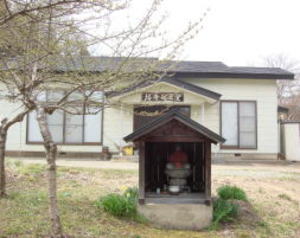
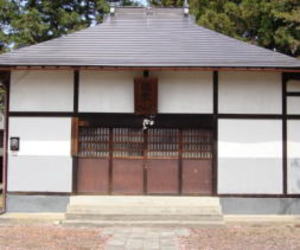
Push the page bottan
Sōtō-sect
Mannenzan Sen-yō-ji temple
Sōtō-sect Keiunzan
Shōhō-ji temple
North of town, it is located at the western end of the 2.2km Shimo-Mandokoro settlement.
Founder of the temple and open temple details are unknown. The Principal
Buddha is the
seated statue of Jizō-Bosatsu.
In the Shinpen-Aizu-Fudoki, it is said that Tenna 3 year (1617
year) was converted from the Shingon-sect to the Sōtō-sect, and the main
statue of the seated
statue of Jizō-Bosatsu was enshrined. There is no record of a fire, and the rot became violent,
it was renovated in Shōwa 11 year (1936 year, the year of February 26th
Incident) and has
been built to the present day. At that time, it is said that the Inner-temple and the Transom
the parts of old times was used. Part of the main hall is used as a meeting
place in the village.
Sōtō-sect Shōeizan
Jūfuku-ji temple
About 2.7 km north of town. Located at the western end of the Nishi-Aozu
village. According to
the Shinpen-Aizu-Fudoki, the founded of a temple was Eiroku 11 year (1568
year). Principal
Buddha is seated statue of Shō-Kannon Bosatsu. There is a Taishi-dō (Prince’s
hall) on the
left side of the precincts, and a statue of Shōtoku-Taishi(Prince Shōtoku)
is enshrined.
The old times of Nishi-Aozu was, it from the confluence of the Tsurunuma-gawa
river and the Ō-kawa
river (Aga-kawa river), the left bank of about 1km downstream of the Tsurunuma-gawa river
side, there was a village to the east of the Unai village. It is said
that it moved to south and
south every time of the flood damage repeatedly, and the present Nishi-Aozu village became
the ground of the permanent residence. It is said that the temple also moved at the same time.
Sōtō-sect Fudōzan
Kōmyō-ji temple
Shingon-sect
Mirokuzan Seigan dilapidated temple
Shingon-sect
Buzan-school Tahōzan Chōei-ji temple
The road in front of Bange Kōsei Hospital go to the south, from the crossing
of JR Tadami Line
about 1.8km, west end of Ushizawa village it is located on a terrace across the Mumyō-bashi
bridge over the Tazawa-gawa river. Principal Buddha is statue of seated Shaka-Nyorai.
Daidō
years (806 year ~ 809 year) when Tokuitsu of Einichi-ji temple, Yama county,
rebuilt the
Takadera, it is said that one of the Takadera 36-Bō(monk house) the Daitoku-Bō, was later
became Daitoku-ji temple. It is said that the bridge in front of the San-mon
gate is called the
Mumyō-bashi bridge, and it is said that it was in the Mimyō village when
the Takadera
Buddhism prospered, and it is reminiscent of the Mumyō-mon(Mimyō-mon) gate. It is said in
Sōtō-sect Gyūtakuzan
Daitoku-ji temple
Sōtō-sect Myōkeizan
Seishō-ji temple
Located at the eastern end of Aizu-Bange town, at the eastern end of the Tsukahara
settlements at the near of the Ō-kawa(Aga-kawa river). (The temple in
the back of the photo
is Manzō-ji temple)
In Aizu-Bange town, the temple of the Tendai-sect is the only one temple
it here.
Tsukahara is in the place where there was a wharf of the Bange side which
Takaku
across the river ferryboat of the Echigo-Kaidō road passed, "Tsuka(mound)"
in other words,
because there were many Kofuns(tumulus), Tsukahara's name is said to have happened. It is
said that these Kofuns were destroyed by repeated floods and the reclamation
of new rice field.
In addition, it is said that the name "Tsukahara" happened from
the place where it was said
Tendai-sect Ryūkozan
Manzō-ji temple
Shō-Hachiman
shrine









